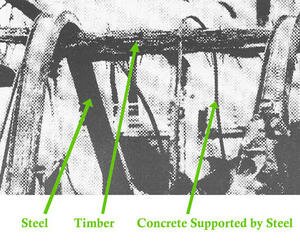Fire Performance
Fire is an emotive subject and is one of the first issues raised when timber frame construction is discussed. However, timberframe buildings must meet the same fire regulations as all other types of construction and therefore pose no greater risk to their inhabitants.
Timber stud partitions and timber joist floors have been used for many years as fire separating elements and their performance has been proven time and time again in test and real fire situations.
 The above illustration shows that when concrete has perished and steel has melted in fire, timber can still take a large load...in a fire, which material would you like your house made out of? |
In the unlikely event of a fire starting within the construction, firestops and cavity barriers prevent fire spread through concealed areas. Timber has a high and predictable performance in fire because timber chars at a slow and known rate: 40mm per hour for European whitewood. More importantly, it retains its structural integrity.
Full scale fire tests undertaken on a six storey 'Timber Frame 2000' demonstration building showed compartmentation and building integrity maintained throughout the test. TRADA and BRE fire safety research concluded that “Timber frame performs as well as other construction in fire�.
Timber burns slowly and resists heat penetration by the formation of a self insulating char. When large timber members are subjected to fire, the uncharred inner portion maintains its strength, giving the structure a higher survival factor.
What Happens to Timber in Fire?
When exposed to heat of a fire, timber undergoes a thermal breakdown (pyrolysis) into combustible gases, and a layer of charcoal forms on the burning surface.
|
Effects of Fire Testing on Glulam timber  A) Original size |
The rate of progress of pyrolysis is governed by the low thermal conductivity of the timber and the lower conductivity of the charred layer, which also hinders the access of oxygen to the timber surface. The total insulating effect of the char and timber is such that temperatures only a short distance in from the char line will not rise sufficiently to impair the strength of the wood.
An experienced structural engineer should design fire resistance of timber structure or contact Benfield ATT for assistance. Other fire protection such as use of fire retardant chemicals to reduce flaming by raising the temperature of ignition and retarding spread of flame are available to meet client's design requirements.
With thanks to Timberbond and the Glued Laminated Timber Association

